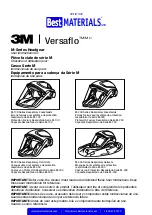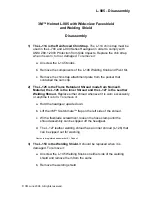
12
CCoonnttrrooll M
Maaiinntteennaannccee
Ikelite controls are designed to provide years of reliable service
with minimal maintenance.
1. Push button controls require no maintenance other than rinsing
in fresh water after saltwater use. If a push button control
becomes difficult to push or if it sticks when depressed, soak the
housing in luke warm fresh water. After a few minutes operate
the push button. If this does not correct the problem, return the
housing to Ikelite for maintenance.
2. Some of the controls have long shafts. These controls can be
pulled out, exposing the shaft (see drawing).
To lubricate the control, gently pull on the knob until the
stainless steel shaft is exposed. Lightly lubricate the shaft, then
move the shaft in and out several times. This will lubricate the
x’ring in the Ikelite control gland. This should be done before
using the housing after a prolonged storage period, or once a
week when the housing is in use.
housing
lubricate shaft
pull out to
expose shaft
13
3. Some of the controls have a short shaft and cannot be pulled
out exposing the shaft for lubrication. In the unlikely event one
of these controls sticks or becomes difficult to operate you can
remove the control from the housing and lubricate it, or return
the housing to Ikelite for maintenance. To remove the control,
loosen the set screw in the knob (allen wrench required);
remove the knob. If there is salt or dirt build-up on the exposed
control shaft, clean the shaft. Open the housing and gently slide
the control shaft out of the control gland. Clean and lightly
lubricate the shaft, including the end of the shaft. Slide the
shaft back into the control gland and gently slide it back and
forth a few times without fully removing the shaft from the
gland. Replace the knob, NOTE the flat area on the shaft, the
set screw in the knob should tighten down against the flat area
on the control so the knob does not turn on the shaft.
Loosen set screw
(allen wrench required)
Flat
Tighten set screw down
against this area when
replacing the knob.
housing
gland
control
shaft
Lubricate end of shaft
before reinserting into
gland
14
O
Oppttiioonnaall AAcccceessssoorriieess
BBaacckk O
O''rriinngg ##00111100
O'rings last for several years if properly maintained.
(See Maintenance) Always carry a spare o'ring in case
the housing o'ring becomes damaged or lost.
U
URR//PPrroo FFiilltteerr ##66444411..4411
EExxtteerrnnaall FFllaasshh
UUssiinngg DDSS SSuubbssttrroobbeess w
wiitthh tthhee EEVV--CCoonnttrroolllleerr..
The Ikelite EV-Controller provides 10 manual power settings in
half-stop increments with the DS51 or DS125 Substrobes. The
EV-Controller can be triggered by the camera's built-in flash or
the optional #4103 sync cord
attached to the housing
bulkhead.
External strobes expand lighting
options to achieve the best
lighting for different subjects.
A second external digital strobe
package can be added to fill
shadows and produce more
realistic photographs.
UUssiinngg IIkkeelliittee SSuubbssttrroobbeess
w
wiitthh SSyynncc CCoorrddss..
Any Ikelite Substrobe,
Substrobe 50, Substrobe DS51,
Substrobe 100, Substrobe DS125
or Substrobe 200 can be con-
nected to the housing and used
in the manual mode with the #4103 sync cord.
Substrobe
DS51 or
DS125
EV-Controller
SA-100Q Arm
15
PPhhoottoo TTiippss
1. The number one rule in underwater photography is eliminate as
much water between camera and subject as possible. Get as
close as you can to the subject, then use the zoom. If you are
using flash, subjects beyond 6 feet (1.8m)will not have much
color.
2. If the camera’s built-in flash is being used it is very close to the
camera lens. The flash will light up any suspended particles in
the water and they will be recorded in your picture. This effect
is called backscatter. To eliminate as much backscatter as
possible, photograph close. Photograph in clear water; do not
stir up the sand or silty bottom. If backscatter becomes a
problem in the environment you are photographing, an external
flash will help eliminate much of the backscatter.
3. Digital cameras have a slight lag time between when you press
the shutter release button and the camera actually takes the
picture. Hold the camera steady a second or two after pressing
the shutter release button.
4. Do not shoot down on subjects as they will quite often blend
into the background and be difficult to see in the photograph.
Shoot subjects straight on or shoot up at a slight angle using
the blue water as a contrasting background.
5. Underwater flash is used to restore the warmer colors filtered
out by the water as well as to illuminate the subject. When
photographing underwater, set the camera to use flash on
every shot. If the camera’s flash is set to AUTO and the sun is
behind your subject, the camera may see enough light that it
does not fire the flash. With the sun behind the subject the
subject is shaded (dark) and needs flash for a good exposure.
All manuals and user guides at all-guides.com
























